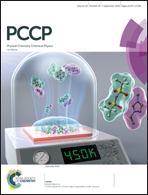A theoretical and shock tube kinetic study on hydrogen abstraction from phenyl formate†
Abstract
The hydrogen abstraction reactions of phenyl formate (PF) by different radicals (H/O(3P)/OH/HO2) were theoretically investigated. We calculated the reaction energetics for PF + H/O/OH using the composite method ROCBS-QB3//M06-2X/cc-pVTZ and that for PF + HO2 at the M06-2X/cc-pVTZ level of theory. The high-pressure limit rate constants were calculated using the transition state theory in conjunction with the 1-D hindered rotor approximation and tunneling correction. Three-parameter Arrhenius expressions of rate constants were provided over the temperature range of 500–2000 K. To validate the theoretical calculations, the overall rate constants of PF + OH → Products were measured in shock tube experiments at 968–1128 K and 1.16–1.25 atm using OH laser absorption. The predicted overall rate constants agree well with the shock tube data (within 15%) over the entire experimental conditions. Rate constant analysis indicates that the H-abstraction at the formic acid site dominates the PF consumption, whereas the contribution of H-abstractions at the aromatic ring increases with temperature. Additionally, comparisons of site-specific H-abstractions from PF with methyl formate, ethyl formate, benzene, and toluene were performed to understand the effects of the aromatic ring and side-chain substituent on H-abstraction rate constants.



 Please wait while we load your content...
Please wait while we load your content...